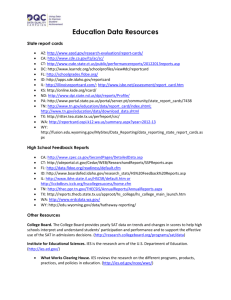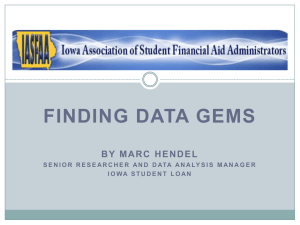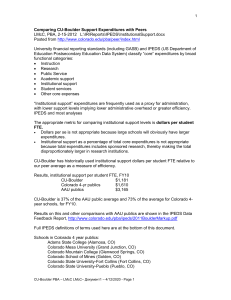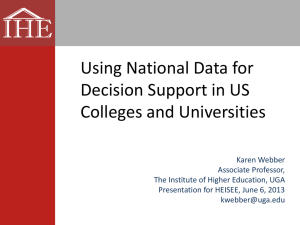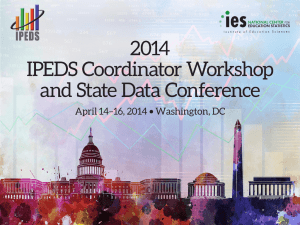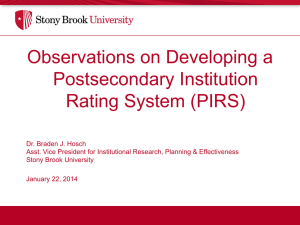Integrated Postsecondary Education Data System (IPEDS)
advertisement
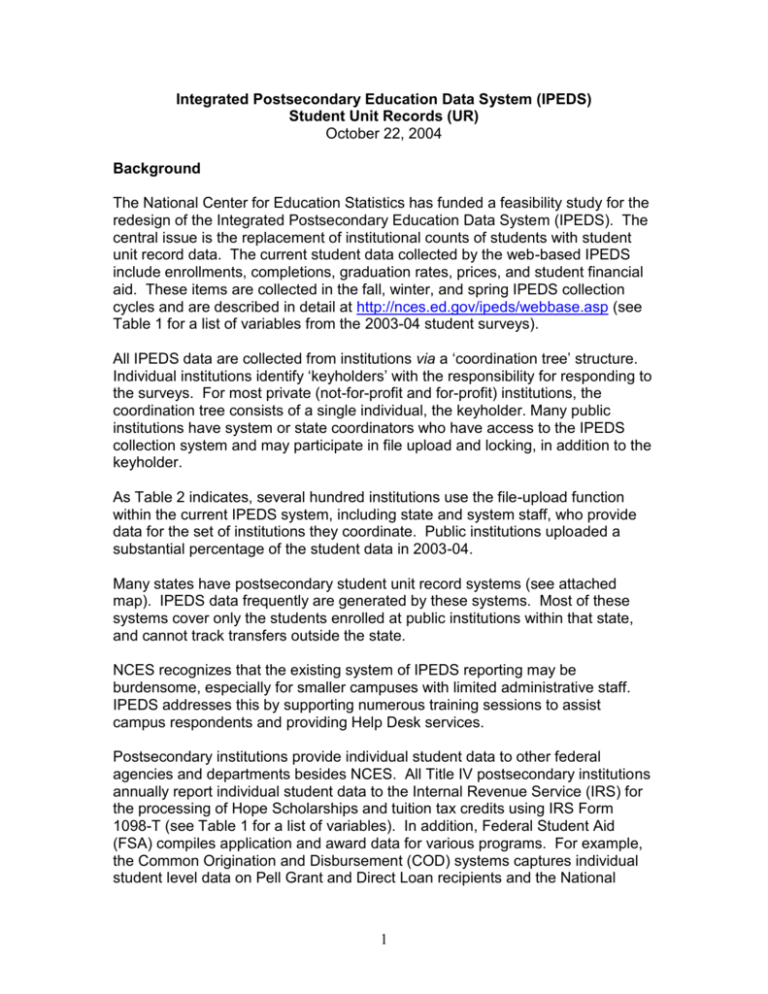
Integrated Postsecondary Education Data System (IPEDS) Student Unit Records (UR) October 22, 2004 Background The National Center for Education Statistics has funded a feasibility study for the redesign of the Integrated Postsecondary Education Data System (IPEDS). The central issue is the replacement of institutional counts of students with student unit record data. The current student data collected by the web-based IPEDS include enrollments, completions, graduation rates, prices, and student financial aid. These items are collected in the fall, winter, and spring IPEDS collection cycles and are described in detail at http://nces.ed.gov/ipeds/webbase.asp (see Table 1 for a list of variables from the 2003-04 student surveys). All IPEDS data are collected from institutions via a ‘coordination tree’ structure. Individual institutions identify ‘keyholders’ with the responsibility for responding to the surveys. For most private (not-for-profit and for-profit) institutions, the coordination tree consists of a single individual, the keyholder. Many public institutions have system or state coordinators who have access to the IPEDS collection system and may participate in file upload and locking, in addition to the keyholder. As Table 2 indicates, several hundred institutions use the file-upload function within the current IPEDS system, including state and system staff, who provide data for the set of institutions they coordinate. Public institutions uploaded a substantial percentage of the student data in 2003-04. Many states have postsecondary student unit record systems (see attached map). IPEDS data frequently are generated by these systems. Most of these systems cover only the students enrolled at public institutions within that state, and cannot track transfers outside the state. NCES recognizes that the existing system of IPEDS reporting may be burdensome, especially for smaller campuses with limited administrative staff. IPEDS addresses this by supporting numerous training sessions to assist campus respondents and providing Help Desk services. Postsecondary institutions provide individual student data to other federal agencies and departments besides NCES. All Title IV postsecondary institutions annually report individual student data to the Internal Revenue Service (IRS) for the processing of Hope Scholarships and tuition tax credits using IRS Form 1098-T (see Table 1 for a list of variables). In addition, Federal Student Aid (FSA) compiles application and award data for various programs. For example, the Common Origination and Disbursement (COD) systems captures individual student level data on Pell Grant and Direct Loan recipients and the National 1 Student Loan Data System (NSLDS) captures data on all students received Title IV loans and Pell Grants. Currently, FSA files contain unit records for roughly two-thirds of all undergraduates. The NSLDS requires enrollment verifications to determine loan deferments. Institutions use FSA provided rosters or vendor services to verify student enrollment several times each year. Since there are only aggregate data available in the current IPEDS, there is no linkage to program outcomes (e.g., graduation rates) that are needed for the Government Performance and Results Act (GEPRA) and the Performance Assessment Rating Tool (PART). Consequently, OPE has relied on the National Postsecondary Student Aid Study (NPSAS) and other NCES sample-based studies for some of the outcomes and indicators needed for GEPRA and PART. Why redesign IPEDS to incorporate unit records? IPEDS UR data would be substantially better than the current IPEDS. The quality increase would be very large. By incorporating UR into IPEDS, the safety and stability of NCES minimize the risks. Finally, IPEDS technology has evolved to the point that IPEDS can incorporate UR efficiently. The IPEDS Graduation Rate Survey (GRS) tracks a cohort of first time, full time undergraduate students. The current IPEDS GRS cannot track students who transfer, co-enroll, stop-out, and shift between full-time and part-time enrollment status. IPEDS UR will produce aggregate indicators for persistence, retention, transfer, co-enrollment, and graduation rates for full-time AND part-time students. In addition, IPEDS UR will produce graduation rates for institutions, sectors, states, and the entire postsecondary system. The current IPEDS Fall Enrollment survey (EF) does not give a comprehensive picture of postsecondary enrollments. While the fall term remains an important focus for many postsecondary institutions, there are other institutions that use rolling terms and enroll substantial numbers of students in non-fall terms. Full year enrollments are needed. EF double counts students who are co-enrolled. Some information is collected for the ED/Office for Civil Rights (OCR), but the EF does not provide enrollment counts for all programs. The IPEDS Prices and Student Financial Aid collections do not contain sufficient detail for calculation of total price of attendance or net price. Both of these prices are useful to students and parents and will be needed if a net price calculator is added to IPEDS COOL. 2 The IPEDS Completions information is in the best shape within the IPEDS suite of studies. The counts of degree completers are very detailed and reasonably timely. However, the addition of time-to-degree information is needed. IPEDS should be more useful for ED, the states, and institutions. ED, especially OPE, needs more accurate IPEDS data for GEPRA and PART compliance. GEPRA and PART demands for accountability information, given the billions of dollars in federal student financial aid, will continue to increase. Many states need better indicators for public institutions for accountability, workforce initiatives, and other policy concerns. All institutions need a portfolio of indicators, especially as displayed on IPEDS COOL, which provide an accurate and comprehensive picture to parents and students. How would an IPEDS UR system work? The preliminary plans for an IPEDS UR system would involve file-upload of records for individual students by each institution (see Table 3 for a list of variables). Several different types of records would be uploaded throughout the year, primarily identifying enrolled students and completers. All uploaded files with unit record information will reside on secure NCES servers. NCES legislation, regarding the protection of records and privacy, mandates a basic rule for all the UR data: Information about individuals may NEVER leave NCES. Only aggregates, based on a sufficient number of individuals such that no disclosure will occur, may be transmitted outside the UR system (see discussion of possible changes in legislation related to disclosures below). The proposed UR system would provide aggregations to populate the IPEDS Peer Analysis System (PAS), replacing the EF, C, GRS, and Prices/Student Financial Aid components. A beginning list of variables, based on this goal, is attached in Table 3. All aggregates based on UR within the PAS would follow the same rules as current values. That is, the GRS and Student Financial Aid data would be subject to perturbation procedures to prevent individual disclosures. Beginning in 2005-06, FSA will require all Title IV institutions to transmit FSArequired data using XML tags. NCES will continue to work with FSA and hopes to get ALL of the IPEDS variables through the Postsecondary Electronics Standards Council and included within the XML Registry by 2006-2007. Keyholders and coordination tree members would be asked to review collection system aggregations, just as they do now, prior to locking the data from migration to the PAS system. The timing of this review may need to be shifted for the EF, C, GRS, and Prices/Student Financial Aid surveys. However, the responsibility for providing quality data would remain with the IPEDS keyholders. As is the 3 case now, if the institution’s coordination tree does not include anyone other than the IPEDS keyholder, then only the IPEDS keyholder will have access to the institution’s data. The timing for term and completions files would need to accomodate appropriate and flexible dates (e.g.,drop/add dates, tuition refund dates, and graduation dates). The use of XML should allow vendors to adapt quickly to this new data collection. As the system matures, edit failures will be minimized and better data integrity will be assured. Will the IPEDS UR system be safe? The NCES IPEDS UR system will be as safe and secure as the systems at IRS. It is a Class E felony, with a $250,000 fine and a 5-year jail term, for NCES to allow a disclosure of individual data. NCES has a long history of protecting students’ data in studies like the National Postsecondary Student Aid Study and there has NEVER been an illegal disclosure. How may the UR data be disclosed? NCES would require legislative authorization for four possible disclosures: 1. By January 31 of each year, a ‘Mail Merge’-type file would be provided to each institution’s keyholder. This file may be used to create the IRS 1098T forms that need to be mailed to each student/parent. (This may not technically be a disclosure because the keyholder had the data initially.) 2. A compilation of the IRS 1098-T information would be provided by NCES to the IRS. This would eliminate the need for each institution to file 1098T data with the IRS. 3. On a routine schedule throughout the year, FSA would submit rosters for enrollment verifications in the NSLDS. The IPEDS system would return to FSA an indicator of current enrollment. 4. Samples of records would be provided to licensed researchers following the standard NCES procedures, including data swapping to prevent disclosures. The NCES Commissioner or the Director of the Institute for Education Sciences may not allow these samples, or may limit samples to the National Postsecondary Student Aid Study. What is the timeframe for getting a unit record system tested and operational? NCES will NOT begin to implement any part of IPEDS UR unless it is mandated by Congress, most likely in the context of reauthorizing the Higher Education Act 4 (HEA). Assuming HEA has been amended by the summer of 2005, NCES would conduct a field test of IPEDS UR as part of the 2006-2007 IPEDS collection. Full scale IPEDS UR would begin in 2007-2008. There would be start-up expenses for IPEDS UR. Additional funds for IPEDS would be needed in FY 2006. NCES cannot begin to implement IPEDS UR without these additional appropriations. What will the field test do? NCES uses field tests to test data collection systems prior to full-scale operations. The IPEDS UR field test would test software and equipment, using a sample of institutions and states to provide IPEDS UR data. The regular IPEDS collection system would continue to operate for ALL institutions during the field test. Based on the results of the field test, NCES would eliminate as many bugs as can be found, identify training needs, and prepare for the full-scale implementation. NCES would rely on the assistance of Technical Review Panels, in addition to its contractors, to reduce the incidence and severity of problems in the full-scale implementation. How will the reporting burden for institutions increase or be reduced? There would be a substantial increase in the burden placed on institutions during the first year. The IPEDS burden would begin to stabilize the second year. With the elimination of the current EF, C, and GRS collections, the burden may decline slightly. Every effort would be made to resolve problems and adjust procedures in a timely manner. For some campuses, it may be a real challenge to put together the data from different offices (e.g., registrars, student aid). A large proportion of the increase in burden for the first year would be associated with the need for cohort data in GRS. All student records for all cohorts would need to be provided to the IPEDS UR system. This may be a large collection of records for some institutions. The first year of any system change is difficult. NCES would field test the UR collection system, but some bugs may be missed. In the long run, the shift to IPEDS UR is comparable to the shift from paper to the web for IPEDS and would be equally if not more beneficial. NCES would provide training to quickly address problems as they arise. NCES would work with vendors, FSA, and others to get as many benefits from XML as possible. The current IPEDS collections for Institution Characteristics, HR 5 (Employees by Assigned Position, Faculty Salaries, and Fall Staff), and Finance would continue to operate as they do currently. The IPEDS Help Desk activities would continue to serve respondents and will remain open all year to deal with IPEDS UR problems. What would be the benefits? IPEDS UR data would be substantially more useful to postsecondary institutions and ED than the current IPEDS. For institutions, better and more appropriate indicators would be available that reflect the diversity of missions. The information would be more detailed and comprehensive. There would be many improvements for ED, including better aggregate measures for GEPRA and PART, more compatible data among ED offices, and reduced burden. 6 Table 1. Integrated Postsecondary Education Data System, 2004 student surveys and IRS 1098-T Survey Variable EF Count of students C GRS Count of awards Cohort count Award count Transfer count Exclusion count Prices Tuition and fees Books Room & board Other expenses SFA Federal grants State grants Institutional grants Loans By variables Gender by Race/ethnicity Intensity (full- & part-) Student type (1st-time, UG, 1st prof, Graduate) CIP subset for OCR First year retention (full- & part-) Age Residence and migration Student credit hours Gender by Race/ethnicity CIP (full 6-digit detail) Award type (certificate, associates, bachelors, …) Gender by Race/ethnicity Award type (certificate, associates, bachelors) Sport Full-time, full-year, 1st time students Percentage receiving Average received IRS 1098-T Variable By variables Name Filer's name Permanent address SSN Tuition & expenses Payments and billed amounts Scholorships or grants Refunds Half-time status Graduate status 7 Table 2. Percent of institutions that uploaded data, by sector and component, IPEDS 2003-04 EF C Sector Upload Cases Percent Upload Cases Percent Adm unit Public 4 226 644 35.1% 242 637 38.0% Private nfp 4 24 1580 1.5% 82 1576 5.2% Private for-profit 4 50 333 15.0% 38 330 11.5% Public 2 202 1156 17.5% 270 1148 23.5% Private nfp 2 1 230 0.4% Private for-profit 2 1 772 0.1% Public <2 2 247 0.8% Private nfp <2 Private for-profit <2 2 1324 0.2% total 503 6409 7.8% 637 6381 10.0% Sector Adm unit Public 4 Private nfp 4 Private for-profit 4 Public 2 Private nfp 2 Private for-profit 2 Public <2 Private nfp <2 Private for-profit <2 total GRS SFA Upload Cases Percent Upload Cases Percent 118 585 20.2% 9 1251 0.7% 1 211 0.5% 217 1149 18.9% 1 236 0.4% 346 5678 6.1% 41 591 1 1268 3 282 73 1153 6.9% 0.1% 1.1% 6.3% 118 5925 2.0% 8 Table 3. Data elements needed for IPEDS unit record system Variable Name Last, First Middle Address ITIN aka SSN Local address Date of birth Gender Race/ethnicity Program, CIP 6-digit Degree plan Sport* (SRK change possible) Exclusion flag Number of courses Credit hours Tuition and fees Total price of attendance Federal grants (all nonreturnable) State grants (all nonreturnable) Institutional grants Loans Assistantships Degree(s) granted Degree date Record ALL Header ALL Header ALL Header Header Header Header Header Term Term Term Term Term Term Term Term Term Term Grads Grads Requirement IRS 1098-T IRS 1098-T, EF-R&M IRS 1098-T IRS 1098-T EF-Age EF, C, GRS EF, C, GRS EF-OCR, C GRS GRS GRS EF, GRS EF, GRS IRS, Prices IRS, Prices IRS, SFA IRS, SFA IRS, SFA SFA SFA C, GRS C, GRS 9 10
